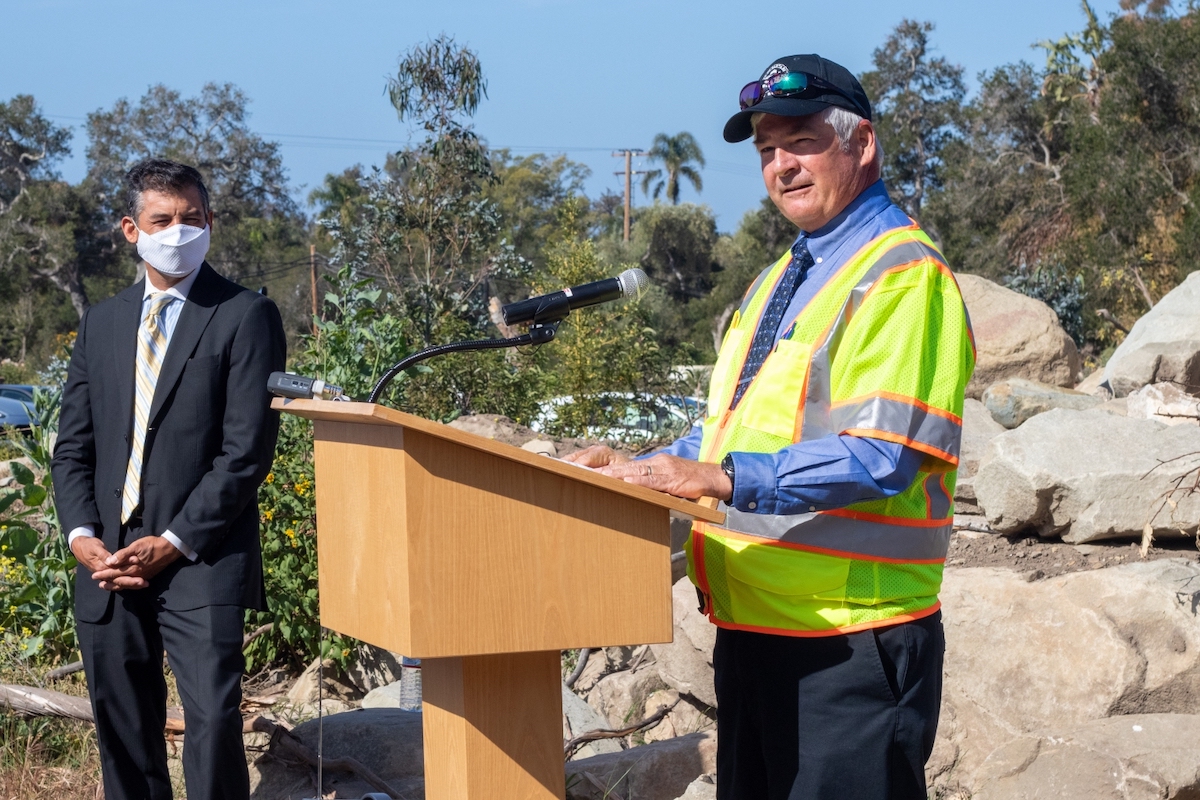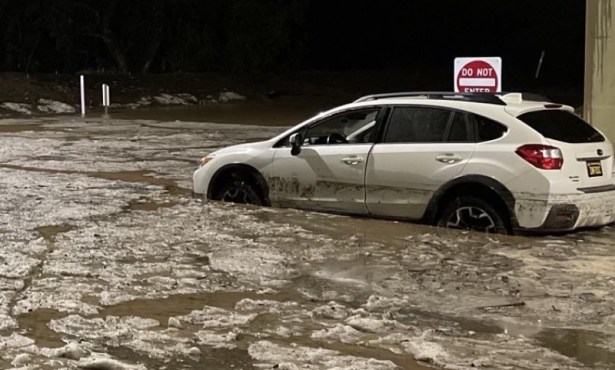Santa Barbara Water Czar Tom Fayram Retires
County Supervisors Give a Standing Ovation

“You know what they say: Old fishermen never die; they just smell that way,” quipped Tom Fayram — ardent fisherman; Green Bay Packers football fan; and, for the past 27 years, the county’s resident Wizard of Oz when it comes to flood control and water policy. As of December 10, however, Fayram will no longer be holding down the top spot at the County’s Water Resource Agency. At 61, Fayram will be joining the ranks of the recently retired. Even in the best of times, Fayram’s position is both technically and politically grueling. And the past four years — when fire, flood, drought, debris flows, death, and more drought have rained down upon Santa Barbara County — have been anything but the best. “I’m ready to let go,” he said. “I’m ready to take a break.”
At age 61, Fayram is still young enough to smell a few roses with his wife, Cathy, who retired last year after a 33-year career in education. During the supervisors’ tribute at the December 7 meeting, Fayram got choked up. The real praise, he insisted, belonged to the people in his department who did all the heavy lifting: the ones, for example, who managed to scrape out all Montecito’s debris basins just seconds — or so it seemed — before the torrential rains descended on the heels of the Thomas Fire. “They’re the best,” he declared. “And I know this.”
In his farewell remarks, Fayram also cited the work done by his daughter-in-law, a nurse who has worked nights on the front lines in the fight against COVID these past 18 months. “I think you got the wrong Fayram here today,” he said.
Just two years after Fayram started work as a front-line engineer, the county entered into what was then one of the worst droughts in its history. “I don’t think I fully appreciated just how close we came to empty,” he said. It was that drought that gave rise to Santa Barbara’s decision — bitterly opposed by environmentalists — to hook up to the State Water Project. None of the supervisors bothered mentioning that the state’s current drought — hotter and drier than any on record — is so bad that statewide water czars in charge of California’s water conveyance system decreed that not one drop of water go to any of the subscribing water agencies, such as Santa Barbara’s, this year. Even with the rains predicted later this week, that picture is not expected to change.
Earlier, California Governor Gavin Newsom demanded state water customers and the agencies serving them cut back water use by 15 percent. This past week, Newsom upped his rhetorical ante, threatening fines as high as $500 to those who fail to do so. In Santa Barbara — where customers are using 25 percent less water than they did in 2013 — there’s pushback against one-size-fits-all state mandates.
Whether localized exceptions can be made in this dire context has yet to be addressed. According to the supervisors this past Tuesday, if anyone could get the county an exception, it would have been Fayram. Nobody, they said, knew how to lobby state and federal decision makers for money and regulatory relief better than Fayram.
Scott McGolpin, the county’s Public Works Chief, gave a clear example of Fayram’s skill. Describing a trip he took with Fayram to D.C. to lobby federal officials for money, McGolpin said he had fully expected to meet with the usual California elected representatives such as Congressmember Lois Capps and Senator Diane Feinstein. Instead, he found himself taking a subway ride to the Pentagon, then trudging 25 minutes through its byzantine underground catacombs, and meeting with an assistant secretary of the army. Fayram wanted money to reinforce a levy six miles long to protect the City of Santa Maria. The assistant secretary, it turns out, hailed from Louisiana, a state where levies are not so much a fact of life as a matter of survival. Fayram outlined the county’s needs, chapter and verse. Years later, in 2009, that meeting paid off big-time. That assistant secretary was now a full-fledged secretary who proved pivotal in the county securing a $47 million to fund the levy effort.
Supervisor Steve Lavagnino said he was always happy to take the credit for such accomplishments, but noted that it was Fayram who knew how to make it happen. He knew all the obscure no-name decision makers in D.C. upon whose advice the likes of Capps and Feinstein relied. That levy, Lavagnino said, saved thousands of homeowners untold millions of dollars in flood insurance they would otherwise have had to pay. It’s easy to tar government administrators as “bureaucrats,” Lavagnino said, but Fayram embodied the alternate reality of “public servant. This is a guy who gets things done.”
Sign up for Indy Today to receive fresh news from Independent.com, in your inbox, every morning.
Fayram moved to the South Coast in 1972 from an idyllic hometown suburb of Milwaukee when his father joined the wave of hundreds of engineers who moved to Goleta, where the company was setting up shop. This wave of R&D eggheads transformed the Goleta Valley and the politics of the South Coast.
In some ways, Fayram never quite left Wisconsin. Today, he remains not just an ardent Cheese Head but a card-carrying municipal stockholder-owner of the Green Bay Packers. But behind his easygoing accessibility, Fayram has also proved to be a skilled and savvy survivor in the twin fields of water management and flood control — endeavors for which there is a conspicuous dearth of safe political ground.
Supervisor Gregg Hart, himself a skilled and savvy master of bureaucratic maneuvers, praised Fayram for executing a “bank shot” in the aftermath of the Debris Flow by trucking the massive quantities of rubble, dirt, and rocks deposited in Montecito to the sand-starved surf zone of Goleta Beach. Then 2nd District Supervisor Janet Wolf bitterly objected to the dumping, questioning whether the sand was safe and contaminant-free. “Tom got a lot of flack for that,” Supervisor Hart said, but as a result, due to the incredible shrinking, Goleta Beach had, for the first time in 30 years, a beach head. By continuing this project through the following year, Hart said, a second beach head has emerged, helping to anchor a beach in full retreat. The environmental community, Hart added, is now embracing this solution. But at the time, he said to Fayram, “You took some hits, but you made the right calls.”
Supervisor Das Williams praised Fayram — who famously got three hours of sleep in the days leading up to and after the 1/9 Debris Flow — for saving not just properties but lives during that deadly onslaught of fire, rain, and geology. He also praised Fayram for taking action in the wake of the flood of March 1995. It had happened on a trash collection day, and the flood carried cans and trash everywhere. In the face of that mess, he crafted a flood protection plan for lower Mission Creek. Traditionally, flood control and environmentalists warred over such plans, but Fayram was one of the first county engineers to work collaboratively with environmentalists. The ensuing flood control plans reflect this give and take. At a time when most politicians operate on four-year time frames, Williams noted, Fayram has been able to conceptualize and execute a plan over a period of decades.
Supervisor Joan Hartmann praised Fayram as “being in a class by himself” and for being “the guardian of the water in our county.” This, she acknowledged, is one of the most controversial issues in the county and currently has Fayram and the county supervisors embroiled in a bitter court battle with the all the county’s individual water agencies that import state water.
Fayram led the charge against a statewide push to allow such agencies to buy and sell their California water entitlements on the state market. He — and a unanimous board of supervisors — insisted it made no sense to allow individual water agencies to sell their water rights outside the county at a time when prolonged drought appears to be the new normal. In so doing, Santa Barbara County is unique in the state. The county’s individual water agencies — as members of the Central Coast Water Agency — have sued the county over this, claiming it exceeded its statutory authority. The case remains in its preliminary jousting phase.
“I stand by my position,” Fayram stated. “We need to manage our water supplies for the benefit for the entire county, not just for some individual water agencies. Before the 2017 temporary reprieve in the current drought, he said, some water agencies did, in fact, sell off water entitlements. That reprieve is now over. “It sure would have been nice to have some of that water we sold off,” he said.
Support the Santa Barbara Independent through a long-term or a single contribution.



